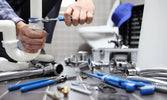
How Shoe Covers Increase Worker Safety
, by Jeff Huff, 2 min reading time

, by Jeff Huff, 2 min reading time
There are many dangers across different fields, and knowing how shoe covers increase worker safety can reduce the risk of injury and infection among employees.
While many people see work-related danger from heavy machinery, falls from great heights, or using sharpened objects such as knives, much less obvious hazards can pose just as much of a threat. These dangers, like spilled liquids and microscopic bacteria, can cause significant harm to employees, customers, and clients alike. You can mitigate these issues, and in some cases eliminate them, by knowing how shoe covers increase worker safety.
Healthcare facilities are sensitive environments that staff meticulously maintain for the benefit of both personnel and patients. Exposure to any foreign germs brought in from the outside, or from one area of the facility to another, can pose a risk to anyone, regardless of if they’re healthy or sick.
People unwittingly track harmful germs on their shoes everywhere they go; most people don’t realize what they step in. Points separating areas in healthcare facilities must offer a spot where anyone can safely apply, remove, and dispose of covers as needed to prevent the risk of cross-contamination.
Spilled liquids can appear in many circumstances, but the chances of it happening are significantly higher in the food industry. Whether in a restaurant, bakery, or fast-food establishment, spilled liquids and other similar substances pose a slipping risk to anyone walking by. Major injuries can result from falls due to these slipping hazards.
Many shoe covers have gritty soles in order for the wearer to maintain their grip on the ground, even when there is liquid present. These non-slip covers allow employees to keep their balance and avoid injuring themselves.
While liquids can cause people to slip, they may also prove toxic, and exposure can mean severe illness. These liquids can be fluids from cars or chemicals in labs, and shoes may absorb these fluids, soaking through to the skin underneath.
Investing in waterproof covers will prevent these fluids from seeping through the material of the shoes, creating a barrier between the shoes and the harmful substance. Much like their use in healthcare, there must be stations where these covers can easily be disposed of and applied.
If you find yourself and your employees exposed to harmful situations, you need to partner with a shoe cover supplier to keep everyone protected. Knowing how shoe covers increase safety will give you insight into what substances are dangerous and what steps you must take to eliminate these hazards.